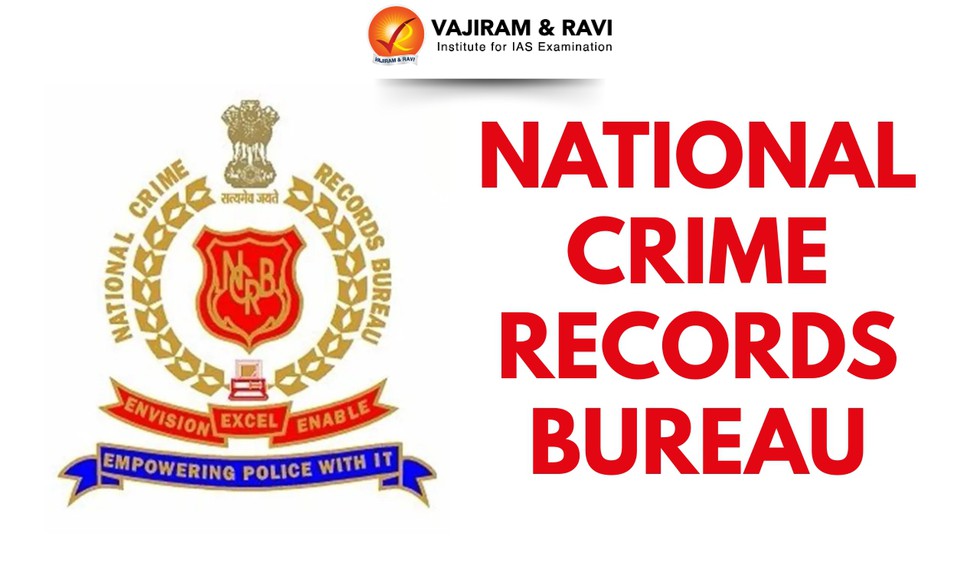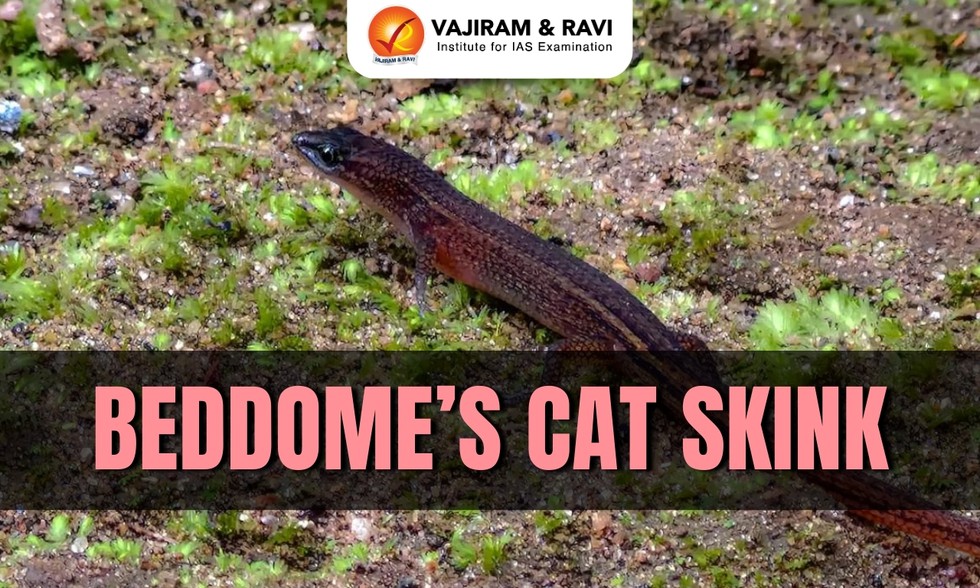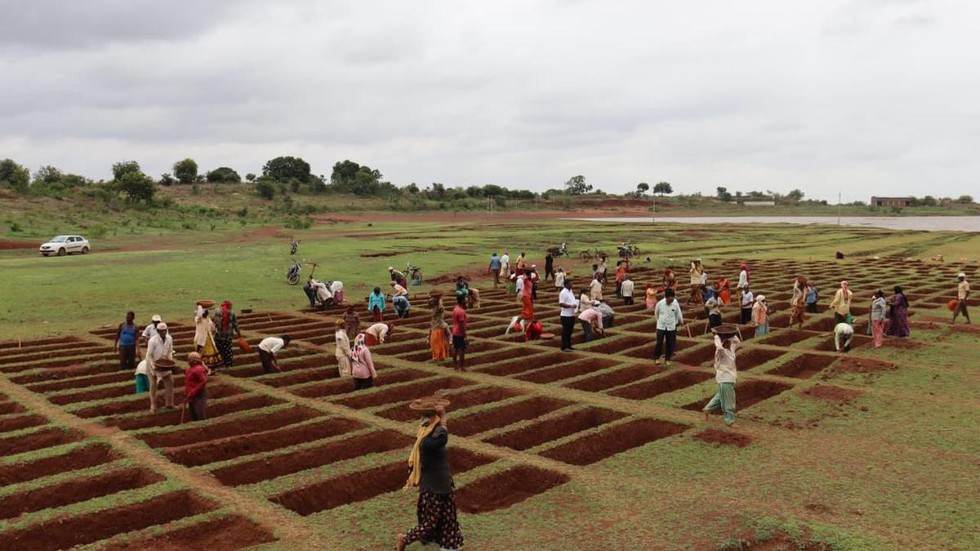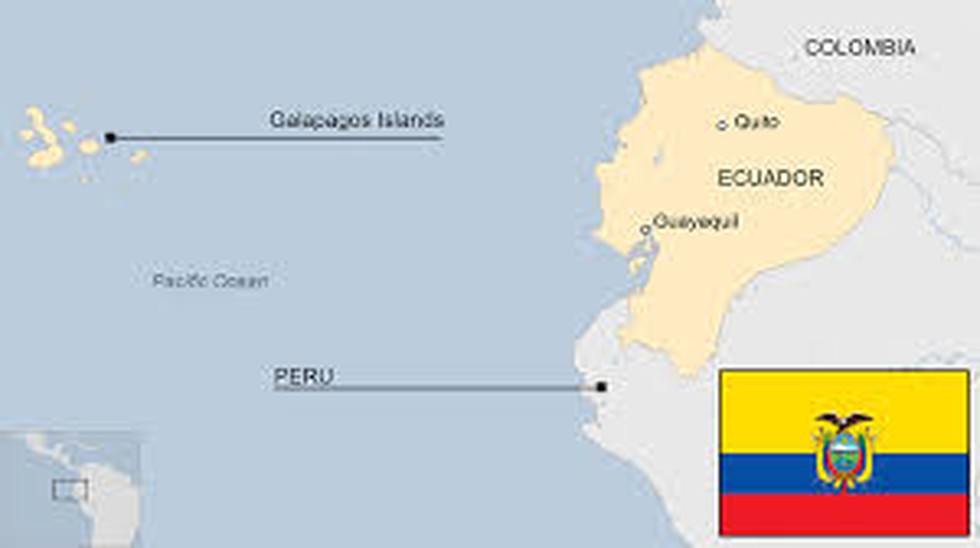Sept. 30, 2025
Prelims Pointers
Sept. 30, 2025

About Hunga Tonga–Hunga Haʻapai (HTHH) Volcano:
- It is a submarine stratovolcano in the Tongan archipelago in the southern Pacific Ocean.
- The HTHH volcano includes the small islands of Hunga Tonga and Hunga Ha’apai, along with shallow reefs along the caldera rim of a much larger submarine edifice in the western South Pacific Ocean, west of the main inhabited islands in the Kingdom of Tonga.
- The volcano is part of the highly active Tonga–Kermadec Islands volcanic arc, a subduction zone extending from New Zealand north-northeast to Fiji.
- The Tonga-Kermadec arc was formed as a result of the subduction of the Pacific Plate beneath the Indo-Australian Plate.
- It has erupted regularly over the past few decades.
What is a Stratovolcano?
- It is a tall, steep, and cone-shaped type of volcano.
- Unlike flat shield volcanoes, they have higher peaks.
- They are typically found above subduction zones, and they are often part of large volcanically active regions, such as the Ring of Fire that frames much of the Pacific Ocean.
- Strato Volcanoes comprise the largest percentage (~60%) of the Earth’s individual volcanoes, and most are characterized by eruptions of andesite and dacite, lavas that are cooler and more viscous than basalt.
- These more viscous lavas allow gas pressures to build up to high levels. Therefore, these volcanoes often suffer explosive eruptions.
- They are usually about half-half lava and pyroclastic material, and the layering of these products gives them their other common name, composite volcanoes.
- At their peak, they usually have a small crater. The crater may be filled with water or ice, or it may contain a volcanic dome during a period of relative inactivity.
Prelims Pointers
Sept. 30, 2025

About Gulf of Aden:
- It is an extension of the Indian Ocean, located between the Arabian Peninsula and the African continent.
- The gulf connects the Red Sea to the Arabian Sea via the Strait of Bab el Mandeb.
- The gulf is named after “Aden,” a port city on Yemen’s coast.
- It is one of the largest natural harbors in the world, with an area of about 70 sq. km of sheltered water.
- It is approximately 900 km long and 500 km wide and covers roughly 410,000 sq.km.
- It is bounded to the south by Somalia and the Socotra Islands (part of Yemen), north by Yemen, east by the Arabian Sea, and west by Djibouti.
- The gulf is connected to the Somali Sea to the south by the Guardafui Channel.
- In the west, it narrows into the Gulf of Tadjoura,near Djibouti.
- It is demarcated from the Arabian Sea by the Horn of Africa and the Socotra Islands.
- The Gulf of Aden is strongly influenced by the upwelling of cool, nutrient-rich waters during the southwest and northeast monsoons and is characterized by a prevailing high-energy climate.
- Major Ports: Aden in Yemen, and Berbera and Bosaso in Somalia.
- It is also a critical part of the Suez Canal shipping route, which connects the Red Sea and the Mediterranean Sea.
- An estimated 11% of seaborne petroleum passes through the Gulf of Aden en route to the Mediterranean or Arabian Seas.
Prelims Pointers
Sept. 30, 2025

About Preponderance of Probability:
- It is a widely accepted standard of proof in civil proceedings.
- The preponderance of probability refers to the greater likelihood of one event or fact over another.
- In this context, a fact is considered proven when the evidence suggests that the occurrence of the fact is more likely than not.
- It is not about certainty or eliminating all doubts but rather about weighing evidence to see which side presents a more probable scenario.
- In civil cases, the party bearing the burden of proof needs to show that their version of events is more plausible than the opposing party’s.
- This standard contrasts sharply with the criminal law standard of “beyond a reasonable doubt,” where the prosecution must prove the defendant’s guilt to a much higher level of certainty.
- In civil cases, by contrast, the balance of probabilities leans toward the more convincing narrative.
- In Narayan Ganesh Dastane v. Sucheta Narayan Dastane (1975), the Supreme Court of India stated that under Section 3 of the Indian Evidence Act, a fact is said to be proved when the court believes in its existence based on a “preponderance of probability.”
- The court applies this test by evaluating conflicting probabilities and choosing the most probable
- Application of Preponderance of Probability in Civil Law:
- The preponderance of probability is the standard of proof used in most civil litigation.
- Civil cases typically involve disputes over rights, contracts, property, or torts, and the plaintiff must demonstrate that their claim is more likely true than false.
- For example, in a breach of contract case, the plaintiff must show that it is more likely than not that the contract was breached.
Prelims Pointers
Sept. 30, 2025

About Antlions:
- Antlions are a group of about 2,000 different species of insects.
- They belong to a family called Myrmeleontidae.
- They are named for the predatory nature of the larvae, which commonly trap ants and other small insects in pits dug into the ground.
- Adult antlions are not as well known. They live for a shorter time than the larvae.
- Adult antlions, sometimes called antlion lacewings, usually fly at dusk or after dark.
- People sometimes mistake them for dragonflies or damselflies.
- Habitat and Distribution:
- Antlions live all over the world.
- Most types are found in warm, tropical places.
- But some species, like the European Euroleon nostras, live in colder areas.
- They often live in dry, sandy places. This is where their larvae can easily dig their traps.
- However, some larvae hide under leaves or other bits of nature. They wait to ambush their prey there.
- They come in various shapes and sizes, with larvae typically measuring from a few millimeters to several centimeters, depending on the species.
- Antlion larvae have rounded bodies with long sickle-shaped jaws.
- The larvae are found at the base of cone-shaped pits in sandy areas.
- In North America, these larvae are sometimes called doodlebugs. This is because of the wiggly marks they leave in the sand.
- They usually remain in the larval stage for one to two years, depending on the species.
- Once they pupate, they require up to one month to complete their development.
- Antlions are harmless and cause no damage to flowers, people, or structures.
- They are highly beneficial and feed on ants and other insects that fall into their traps.
Prelims Pointers
Sept. 30, 2025

About Ophiorrhiza echinata:
- It is a new species of coffee
- It was discovered in the highly biodiversity-rich shola forests of the Western Ghats at Devikulam in the Idukki District of Kerala.
- It grows in the ecotone region between evergreen forest and grassland vegetation at an elevation of 1,630 m above sea level and may have medicinal potential.
- It belongs to the family Rubiaceae and is closely related to the genus Ophiorrhiza mungos, which is a key ingredient in cancer treatment and antidote preparations.
- Ophiorrhiza echinata has so far only been collected from the type locality.
- The area of occupancy is estimated to be less than four square kilometres, and the known populations contain a maximum of only 35 plants.
Prelims Pointers
Sept. 30, 2025

About Swachh Shehar Jodi Initiative:
- It is a structured mentorship and collaborative action program involving 72 mentor cities and around 200 mentee cities.
- Based on their recent performance in the Swachh Survekshan rankings, top-performing cities have been identified as mentor cities and paired with low-performing mentee cities. It is implemented under the Swachh Bharat Mission – Urban (SBM-U).
- It is aimed to foster knowledge and experience sharing, peer learning and transforming best practices in sanitation and waste management across urban India.
- Objectives of Swachh Shehar Jodi Initiative
- The objective is to support comparatively low performing cities in improving their swachhata performance by drawing on the experience of mentor cities to:
- Replicate tested best practices in sanitation and waste management
- It is envisioned that the mentor cities will be those cities that adhere to the following criteria:
- Top performing cities that have featured across Rank 1, 2 or 3 in Swachh Survekshan (SS) 2022, 2023, and 2024 ( i.e. – cities that are part of the Super Swachh League)
- Top three cities that are featured across population categories in SS 2024.
- Promising clean cities that emerge across States/UTs as part of SS 2024.
- The mentee city may be selected on the basis of the following criteria:
- Featured in the bottom of the State cumulative ranking of the latest SS rankings
- Geographical proximity of the jodi cities to each other
- Funding: Both mentor and mentee cities may utilize the Capacity Building (CB) Funds allocated to each State/UT as part of SBM-U 2.0.
State/UT Governments are encouraged to top up this fund, if required. - Cities can also leverage funds from other sources / partner organizations.
Prelims Pointers
Sept. 30, 2025

About Red Sanders:
- It is native to the Southern Eastern Ghats and found particularly in the districts of Anantapur, Chittoor, Kadapa, and Kurnool of Andhra Pradesh.
- Required Climatic Conditions: It usually grows in rocky, degraded and fallow lands with Red Soil and a hot and dry climate.
- Threats: It has been under heavy threat due to its high commercial value, leading to rampant smuggling.
- Conservation Status:
- IUCN: Endangered
- CITES: Appendix II
- The Wildlife (Protection) Act 1972: Schedule IV
Key facts about National Biodiversity Authority:
- It is a statutory body established under the Biological Diversity Act, 2002.
- It was formally set up in 2003.
- Composition of National Biodiversity Authority
- Chairperson: An eminent person with proven knowledge and experience in biodiversity conservation, sustainable use of biological resources, and equitable sharing of benefits.
- 10 Ex-officio Members: Senior representatives from the Government of India, nominated to provide policy insights and ensure inter-ministerial coordination.
- 5 Non-Official Members: Experts and professionals from diverse fields related to biodiversity management, nominated to contribute independent perspectives and specialized expertise.
- To ensure effective implementation of the Act at different administrative levels, two additional entities were created alongside the NBA:
- State Biodiversity Boards (SBBs): Functioning at the state level to regulate access to biological resources within their jurisdiction.
- Biodiversity Management Committees (BMCs): Established at the local village or panchayat level to promote grassroots-level biodiversity conservation and documentation.
- Headquarters: Chennai, Tamil Nadu.
Prelims Pointers
Sept. 30, 2025

About Pallid Fish Eagle:
- It is also known as Pallas’s sea eagle or band-tailed fish eagle, is a large, brownish sea eagle.
- Habitat: It can be seen near lakes, marshes and large rivers, from lowlands to 5,000 metres of elevation.
- Food: It feeds primarily on fish, but many other prey are part of its diet.
- It breeds usually near water in a large nest placed in a tall tree.
- It is partially migratory, with Central Asian birds wintering among the southern Asian birds in northern India, and also further west to the Persian Gulf.
- Distribution: It is found in the east Palearctic in Kazakhstan, Russia, Tajikistan, Turkmenistan, Uzbekistan, Mongolia, China, India, Nepal, Bangladesh and Myanmar.
- Conservation status: IUCN Red List: Endangered
- Threats: Humans contribute to the decline of this species through habitat degradation, pollution, and draining or overfishing lakes.
Key Facts about Corbett Tiger Reserve
- It is located on the foothills of the Himalayas in Uttarakhand.
- It was originally established as Hailey National Park in 1936.
- It is not only the first national park in India, but also the first to come under the Project Tiger initiative.
- Terrain: The terrain is undulating with several valleys. The rivers Ramganga, Pallaen, and Sonanadi flow through the valleys.
- It is spread over the Bhabar and lower Shivalik regions with a deep-water table.
- Vegetation: North Indian tropical moist deciduous forests and tropical dry deciduous forests. In general, the vegetation comprises sal and mixed forests, interspersed with grass lands and riparian vegetation.
Prelims Pointers
Sept. 30, 2025

About Infectious Bovine Rhinotracheitis:
- It is endemic in India and caused by Bovine Herpes Virus (BHV-1).
- BoHV-1 is a member of the genus Varicellovirus in the subfamily Alphaherpesvirinae.
- It is a disease of domestic and wild cattle.
- There are three forms: respiratory, genital and encephalitic, the first two are more common.
- Transmission: The disease is transmitted through the aerosol route and affects reproductive systems. It is also transmitted by semen from bulls to milch animals.
- Symptoms of Infectious Bovine Rhinotracheitis
- It is characterised by clinical signs of the upper respiratory tract, such as a (muco)purulent nasal discharge, hyperaemia of the muzzle (red nose disease) and by conjunctivitis.
- Signs of general illness are fever, depression, inappetence, abortions and reduced milk yield.
- Impacts on Bovines: Infertility, abortions and lower milk productivity are some of the major impacts of the disease.
- Treatment: There is no vaccine available in India and there is no specific treatment against this disease thus far.
Prelims Pointers
Sept. 30, 2025

About National Crime Records Bureau:
- It was established in 1986 to act as a repository of information on crime and criminals.
- It was set up based on the recommendations of the Tandon Committee, the National Police Commission (1977-1981) and the Task Force of the Home Ministry.
- Nodal Ministry: It comes under the Ministry of Home Affairs (MHA), Government of India.
- Headquarters: New Delhi
- Functions of National Crime Records Bureau
- It is responsible for collecting and analysing crime data as well as serving as a repository of such information to aid investigators in tracing crimes and criminals.
- It is entrusted with the responsibility of monitoring, coordination, and implementing the Crime and Criminal Tracking Network and System (CCTNS) project.
- Under the National Digital Police Portal police officers look for a criminal or suspect on the CCTNS database and gives citizens with services such as online complaint filing, etc.
- The Bureau has also been entrusted to maintain the National Database of Sexual Offenders (NDSO) and share it with the States/UTs on a regular basis.
- NCRB has also been designated as the Central Nodal Agency to manage the technical and operational functions of the ‘Online Cyber-Crime Reporting Portal’ through which any citizen can lodge a complaint or upload a video clip as evidence of crime related to child pornography, rape/gang rape.
- The NCRB has also launched CyTrain, a portal for online training of different stakeholders in cybercrime investigations and prosecution.
- The Central Finger Print Bureau under the NCRB is a national repository of all fingerprints in the country.
- NCRB also compiles and publishes National Crime Statistics i.e. Crime in India, Accidental Deaths & Suicides, and also Prison Statistics.
Sept. 29, 2025
Prelims Pointers
Sept. 29, 2025

About AstroSat:
- It is the first dedicated Indian astronomy mission.
- It was launched by PSLV-C30 (XL) rocket from Satish Dhawan Space Centre in Sriharikota on September 28, 2015.
- The minimum useful life of the AstroSat mission was around 5 years but still it is providing valuable information.
- It was designed to observe the universe in the Visible, Ultraviolet, low and high energy X-ray regions of the electromagnetic spectrum simultaneously with the help of its five payloads.
- Payloads of Astrosat: Ultra Violet Imaging Telescope (UVIT), Large Area X-ray Proportional Counter (LAXPC), Cadmium–Zinc–Telluride Imager (CZTI), Soft X-ray Telescope (SXT) and Scanning Sky Monitor (SSM).
- Objectives of Astrosat
- To understand high energy processes in binary star systems containing neutron stars and black holes.
- Estimate magnetic fields of neutron stars.
- Study high energy processes in star systems lying beyond our galaxy.
- Detect new briefly bright X-ray sources in the sky.
- Perform a limited deep field survey of the Universe in the Ultraviolet region.
- The spacecraft control center at Mission Operations Complex (MOX) of ISRO Telemetry, Tracking and Command Network (ISTRAC), Bengaluru, manages the satellite during its entire mission life.
Prelims Pointers
Sept. 29, 2025

About Beddome’s cat skink:
- It is also called Beddome’s ristella.
- It is named after British naturalist Richard Henry Beddome, the species is considered rare and endemic to the Western Ghats region.
- Appearance: It is a small reddish brown lizard with retractile claws and bicarinate scales.
- Distribution: It is found in the forests of the Western Ghats at an altitude of 400-1,300 metres.
- Reproduction: It is an oviparous species and egg laying coincides with the southwestern monsoons.
Key Facts about Skink:
- It is the common name for the lizards that comprise the family Scincidae.
- It is a type of reptile that has been around since the time of the dinosaurs.
- It is typically smooth and shiny with small or rudimentary legs.
- They are mostly secretive ground dwellers or burrowers.
- Behavior: Skinks are highly alert, agile and fast moving and actively forage for a variety of insects and small invertebrates.
- Habitat: They can be found in a variety of habitats, from deserts to rainforests, and are well-known for their ability to camouflage with their surroundings.
- Distribution: These are represented throughout most of the world but are especially diverse in Southeast Asia and its associated islands, the deserts of Australia, and the temperate regions of North America.
Prelims Pointers
Sept. 29, 2025

About Andaman Sea:
- It is a semi-enclosed marginal sea in the northeastern Indian Ocean.
- It lies between the eastern coast of India and the Malay Peninsula, with Myanmar to the north and the Indonesian island of Sumatra to the south.
- The Bay of Bengal bounds the Andaman Sea to the west and the Strait of Malacca to the east.
- It is a complex geological region with a tectonically active plate boundary.
- It is part of the larger Sunda Plate, which the Indian Plate borders to the northwest and the Australian Plate to the southeast.
- The ongoing tectonic convergence between these plates has resulted in the formation of the Andaman Basin, characterized by undersea ridges, trenches, and faults.
- The most prominent geological feature in the region is the Andaman Trench, which is formed by the subduction of the Indian Plate beneath the Eurasian Plate.
- This tectonic activity has given rise to numerous earthquakes and volcanic eruptions in the region, making the Andaman Sea seismically active.
- It is home to extensive coral reef systems, seagrass meadows and mangrove forests, which provide critical habitats for a multitude of marine organisms.
- It hosts many endangered fauna species –Whale Shark, Devil Manta Ray, Dugong, several dolphin species, such as Irrawaddy Dolphin and four species of sea turtles.
- It is also an important site for migratory birds, with several key stopover locations along the East Asian-Australasian Flyway.
- Islands: Most of the islands are part of the Andaman and Nicobar Islands, a Union Territory of India, while the Coco Islands and Preparis Island are part of the Yangon Region of Myanmar.
- The climate of the Andaman Sea is tropical, with two distinct seasons: the southwest monsoon (May-September) and the northeast monsoon (November-February).
Prelims Pointers
Sept. 29, 2025

About Yellow-tailed Ashy Skimmer:
- It is a species of dragonfly in the family Libellulidae.
- Scientific Name: Potamarcha congener
- It is one of two species in its group, called Potamarcha. The other species is Potamarcha puella.
- It is also known as the common chaser, or swampwatcher.
- Distribution: It is common through much of its range, which stretches through parts of South Asia, Southeast Asia, and Oceania, including in countries such as India, Indonesia, China, Australia, and Vietnam.
- Features:
- It is a medium-sized
- Its body is bluish-black near the head.
- Its tail is yellow with black marks.
- The face of this dragonfly can be yellowish-green to dark brown.
- Its eyes are reddish-brown on to They are bluish-grey underneath.
- Male Dragonflies: Adult males have a bluish powder-like coating. This covers their upper body and the first part of their abdomen.
- Female Dragonflies: Females have yellow and black stripes on their sides. Their abdomen is black with dull orange marks.
- It can fly backward, showcasing incredible aerial agility uncommon in other flying insects.
- Conservation Status:
- IUCN Red List: Least Concern.
Prelims Pointers
Sept. 29, 2025

About Agri-Stack Scheme:
- It is the digital foundation being set up by the government to enable the rollout of data-centric digital services to improve Indian agriculture and enable farmer empowerment.
- It integrates farmer data, land records, and scheme benefits into a centralized digital platform.
- It is being implemented by the Ministry of Agriculture and Farmer Welfare at the Centre in close collaboration with the Revenue and Agriculture departments of State governments.
- It is an infrastructure and foundational layer that enables various government and private entities to provide farmers with tailored services by providing them access to high-quality, validated, attested, and current data. Thus, Agri Stack will:
-
- Provide the right support to farmers in terms of finance and agricultural inputs at the right time.
- Provide localized and tailored early warning systems for disasters, including pest attacks, droughts, floods, etc.
- Simplify government scheme benefits lifecycle for farmers.
- Enable quick and easy access to affordable finance.
- Enable private participation in farmer service delivery, thereby increasing farmers' choices.
- Enable ease of governance by providing required data at the right place for enhanced decision-making, policy implementation, and feedback management.
- Improve targeting of government benefits (by maximizing inclusion and minimizing exclusion and fraud).
- Building Blocks of Agri Stack:
- Farmer and Farmland Registries:
- At the center of Agri Stack is a Farmer Registry, a federated registry of all the farmers in the country, compiled by States according to common standards, and cached by the Centre.
- Each farmer will be assigned a unique FarmerID (a functional ID, based on Aadhaar as per IndEA 2.0) and a digitally verifiable credential.
- The Farmer Registry will be dynamically linked to their farmland plot records for non-legal, planning and advisory, and scheme-delivery purposes only.
- Unified Farmer Service Interface (UFSI):
- It is the building block that enables interoperability across stakeholders in Agri Stack.
- UFSI is envisioned to be used by government and authorized private users, such as Banks, Agri-Techs, agriculture value-chain companies, etc.
- UFSI will enable a center-state federation of data, authorized and consent-brokered access to the core registries' data, and standards-based interactions between various public and private stakeholders.
- Crop sown Registry:
- It is designed to be a federated registry of crops being sown and grown across the country every season, on every farm, by each farmer.
- It aims to streamline and improve previously prevalent paper-based methods of surveying crops by introducing smartphone- and image-based (including drone and satellite images in the future), more fool-proof methods of crop survey.
- Agri Stack Sandbox:
- It is a subset of the Agri Stack that will provide a simulated environment with access to the UFSI along with sample data for the various registries and databases to authorized stakeholders.
- Purpose: To allow them to test and safely fail, or succeed and get fully authorized access to the production environments.
- Consent Manager:
- The Consent Manager facilitates data-blind sharing of personal data only with persons/entities for whom the data principal (i.e., a farmer) has provided consent.
- Consent once given may also be revoked, preventing future sharing of data.
Prelims Pointers
Sept. 29, 2025

About PM E-DRIVE Scheme:
- The PM E-DRIVE (Electric Drive Revolution in Innovative Vehicle Enhancement) scheme is a flagship initiative launched in October 2024 with a financial outlay of Rs.10,900 crore.
- It came into effect from October 1, 2024, and will remain in force until March 31, 2026. Its primary aim is to accelerate the adoption of Electric Vehicles (EVs), establish charging infrastructure, and build a robust EV manufacturing ecosystem in the country.
- It promotes mass mobility through the support of public transportation systems.
- The key objective is to speed up the transition to EVs by offering upfront incentives for EV purchases and encouraging the development of charging infrastructure.
- The scheme seeks to reduce transportation-related environmental impacts and improve air quality while also promoting an efficient and competitive EV manufacturing sector in line with the Aatmanirbhar Bharat initiative.
- This is to be accomplished through a Phased Manufacturing Program (PMP) designed to boost domestic manufacturing and strengthen the EV supply chain.
- The PM E-DRIVE scheme to be implemented through the following key components:
- Subsidies: Demand incentives to be provided for electric vehicles such as e-2 wheelers (e-2W), e-3 wheelers (e-3W), e-ambulances, e-trucks, and other emerging categories of EVs.
- Grants for creation of capital assets: Funding to be provided for the acquisition of electric buses (e-buses), the establishment of a comprehensive network of charging stations, and the upgrading testing facilities of the Ministry of Heavy Industries (MHI).
- Administration of the Scheme including IEC (Information, Education & Communication) activities and fee for project management agency (PMA).
- States are encouraged to offer additional fiscal and non-fiscal incentives, such as road tax waivers, reduced toll and parking fees, and permit exemptions, to further promote EV adoption.
- The scheme will be overseen by an inter-ministerial body, the Project Implementation and Sanctioning Committee (PISC), chaired by the Secretary of Heavy Industries.
- The PISC will be responsible for monitoring progress and ensuring the scheme’s successful rollout.
- It will also have the authority to address any challenges, including revising incentives, increasing the number of e-buses, and approving guidelines for testing agencies.
- To qualify for the PM E-DRIVE incentives, vehicles must be registered as “Motor Vehicles” under the Central Motor Vehicle Rules (CMVR) and equipped with advanced battery technology.
- Bharat Heavy Electricals Limited (BHEL) is the nodal agency for:
- Demand aggregation for charging infrastructur
- Development of a Unified EV Super App for users across India.
- The app will offer real-time charger availability, slot booking, payment integration, and deployment progress tracking, ensuring digital ease-of-use for all EV stakeholders.
Prelims Pointers
Sept. 29, 2025

About Study In India (SII) Portal:
- It is a flagship project of the Ministry of Education (MoE), Government of India, to encourage international students to explore educational opportunities at top Indian universities.
- It is a single-window interface for international students, which facilitates submission of applications, admission processes, and visa applications for those seeking to pursue regular, short-term, or long-term courses in Indian academic institutions or HEI’s.
- It serves as a seamless digital gateway to India’s higher education ecosystem.
- The website will illustrate academic programs, including undergraduate (UG), postgraduate (PG), and doctoral-level programs.
- It will also provide information about courses in the Indian Knowledge System, such as Yoga, Ayurveda, classical arts, etc
- Additionally, the portal will present information about the academic facilities, research support, and related information.
- All foreign students who wish to study in India, are mandated to register on the SII portal and submit the required information on the portal.
- Upon registration, the portal generates a unique ID or ‘SII-ID’, which must be quoted on the student visa application.
Prelims Pointers
Sept. 29, 2025

About Bhima River:
- The Bhima River (also known as the Chandrabagha River) is the largest tributary of the Krishna
- Course:
- It originates near Bhimashankar Temple in the Bhimashankar hills on the western side of the Western Ghats in Pune District of Maharashtra.
- Bhima flows southeast through the states of Maharashtra, Karnataka, and Telangana.
- It merges into the Krishna River in Karnataka’s Raichur district.
- Total Length: 861 km
- The Bhima drainage area is defined by the Western Ghats (west), the Balaghat Range (north), and the Mahadeo Hills (south).
- The total basin area of the river is 48,631 sq.km., out of which 75 percent lies in the state of Maharashtra.
- Tributaries: Major tributaries are the Indrayani River, Mula River, Mutha River, and Pavana River.
- Pandharpur is an important pilgrimage centre located on the right bank of the Bhima River.
Prelims Pointers
Sept. 29, 2025

About Jal Prahar 2025:
- It is a biannual joint amphibious exercise conducted by the Indian Navy in close coordination with the Indian Army
- The Jal Prahar 2025 showcased synergy, coordination, and interoperability between the Indian Navy and Indian Army, enhancing operational readiness, maritime security and national defence capabilities.
- The exercise was conducted in two phases:
- The Harbour Phase at Visakhapatnam focused on the induction and integration of army troops onboard INS Gharial.
- This included onboard training, safety briefings, orientation towards a mariner’s life, sports and interactions sessions to foster camaraderie, the release stated.
- The Sea Phase witnessed the execution of amphibious operations, which included hard beaching at Kakinada, launching of LCAs and BMPs, and validation of SOPs and Joint Training Protocols.
Prelims Pointers
Sept. 29, 2025

About Lachipora Wildlife Sanctuary:
- It is situated in the Baramulla district of Jammu and Kashmir near the village of Lachipora.
- It is located on the northern banks of the Jhelum
- Established in 1987, the sanctuary was primarily created to protect the endangered Markhor, a wild goat species known for its distinctive twisted horns.
- It hosts alpine meadows and rich biodiversity.
- The sanctuary features a diverse landscape with gentle to steep slopes and rocky cliffs.
- Flora: It supports a variety of flora, including coniferous forests of deodar, Himalayan white pine, and blue pine, and broadleaf forests with trees like birch, horse chestnut, West Himalayan fir, and Persian walnut.
- Fauna:
- It is particularly renowned for being the habitat of the endangered Hangul deer, often referred to as the Kashmir stag.
- It is also home to several other mammal species, such as the Himalayan black bear, Snow leopard, Musk deer, and many more.
- Lachipora is also designated as an Important Bird Area (IBA). It is home to the vulnerable Western Tragopan bird.
Sept. 28, 2025
Prelims Pointers
Sept. 28, 2025

About Armed Forces (Special Powers) Act (AFSPA), 1958:
- It is a law enacted by the Parliament in 1958 which gives the armed forces special powers and immunity to maintain public order in “disturbed areas”.
- When is it applied? It can be applied only after an area has been declared “disturbed” under section 2 of the Act.
- Declaration of Disturbed Areas:
- Defined under Section 3 of the Act, a “disturbed area” is where the use of armed forces is deemed necessary to support civil authorities in maintaining law and order.
- An area can be declared disturbed due to conflicts or disputes between various religious, racial, linguistic, regional, or caste-based communities.
- The central government, Governor of the state, or the administrator of the Union Territory can declare the whole or part of a state or union territory as a disturbed area.
- Once declared, the region is maintained as disturbed for at least three months under The Disturbed Areas (Special Courts) Act, 1976.
- The scope and duration of AFSPA can vary depending on the region’s security situation.
- The ‘special powers’ of armed forces under AFSPA are:
- They have the authority to prohibit a gathering of five or more persons in an area, can use force even to cause death or even open fire after giving due warning, if they feel a person is in contravention of the law.
- If reasonable suspicion exists, the army can also arrest a person without a warrant, enter or search a premises without a warrant, and ban the possession of firearms.
- Any person arrested or taken into custody may be handed over to the officer in charge of the nearest police station along with a report detailing the circumstances that led to the arrest.
- These armed forces are immune from prosecution unless the Union Government provides sanction to the prosecuting agencies.
- Where is AFSPA in force now? Currently, AFSPA is active in Assam, Manipur, Nagaland, Arunachal Pradesh, and the UT of J&K.
Prelims Pointers
Sept. 28, 2025

About Syphilis:
- It is a preventable and curable bacterial sexually transmitted infection (STI) that can cause serious health problems if you do not treat it.
- It is caused by the bacteria, Treponema pallidum.
- After the infection happens, syphilis bacteria can stay in the body for many years without causing symptoms. But the infection can become active again.
- Transmission:
- People usually get syphilis from sexual contact with someone who has it.
- People get it if any part of their body touches the sore or rash of someone with syphilis.
- It can also pass from mother to baby during pregnancy, childbirth, and sometimes through breastfeeding.
- Symptoms:
- Syphilis develops in stages.
- The disease starts as a sore that’s often painless and typically appears on the genitals, rectum, or mouth.
- Sometimes it causes swelling in nearby lymph nodes.
- If you do not treat it, syphilis usually causes a non-itchy skin rash, often on your hands and feet.
- Many people do not notice symptoms for years. Symptoms can go away and come back.
- Without treatment, syphilis can damage the heart, brain, or other organs. It can become life-threatening.
- Syphilis in pregnancy, when not treated, treated late, or treated with the incorrect antibiotic, results in 50−80% of cases with adverse birth outcomes.
- Treatment:
- It is easy to cure with antibiotics, especially during the early stages.
- Penicillin is the most commonly used medication for syphilis.
Prelims Pointers
Sept. 28, 2025

About Oju Hydel Project:
- It is a hydroelectric project proposed on the Subansiri River (right-bank tributary of the Brahmaputra) in Taksing, Arunachal Pradesh, near the China border.
- The project, to be developed by Oju Subansiri Hydro Power Corporation Pvt. Ltd., envisages generating 2,220 megawatts of electricity through a run-of-the-river scheme with daily peaking capability.
- It involves a 100-metre-high concrete gravity dam, a 14.12 km headrace tunnel, and an underground powerhouse complex.
- With an estimated cost of over Rs 24,942 crore, the dam is expected to produce 8,402 million units of electricity annually.
- It is the largest in a series of dams proposed on the Subansiri River, often described as the lifeline of Assam.
Prelims Pointers
Sept. 28, 2025

About Amrabad Tiger Reserve:
- It is located in the Nallamala hills of the Eastern Ghats in Telangana
- It covers a total area of 2,611.39 sq.km, with 2,166.37 sq.km designated as the core area.
- In terms of core area, it is the second-largest tiger reserve in India.
- This expansive reserve was originally part of the larger Nagarjunasagar-Srisailam Tiger Reserve before the bifurcation of Andhra Pradesh and Telangana in 2014.
- The reserve is renowned for its rugged terrain, deep valleys, and dense forests.
- Within the reserve lies the historic Nagalapuram fort.
- The Krishna River and its perennial streams originating within the reserve contribute to the water supply of major reservoirs such as the Srishailam Dam and Nagarjunsagar Dam.
- The Chenchu tribe is one of the major tribal communities that live in the ATR.
- Flora:
- Amrabad is characterized by dry deciduous forests, primarily made up of sal, teak, bamboo, and acacia trees.
- The forest is rich in medicinal plants and shrubs, which have long been used by local tribes for traditional remedies.
- Fauna:
- Apart from tigers, the reserve supports a range of other big cats, such as leopards and wild cats, along with herbivores like sambar deer, chital (spotted deer), nilgai (blue bull), wild boar, and the Indian bison (gaur).
- Over 303 bird species have been identified in this region. Some important groups include Eagles, Pigeons, Doves, Cuckoos, Woodpeckers, Drongos, etc.
Prelims Pointers
Sept. 28, 2025

About Ethambutol Hydrochloride:
- It is an antibacterial prescription medicine used for the treatment of tuberculosis (TB).
- It is a synthetic, water soluble, heat stable
- It is specifically effective against actively growing microorganisms of the genus Mycobacterium including tuberculosis.
- It is used to combat both pulmonary and extrapulmonary tuberculosis.
- Mechanism:
- Ethambutol (HCl) specifically targets the synthesis of the cell wall in M. tuberculosis.
- By interfering with the polymerization of arabinogalactan, a key component of the mycobacterial cell wall, Ethambutol disrupts the structural integrity of the bacteria, leading to its demise.
- Its unique mode of action is fundamental in combination therapies, where it is often used in conjunction with other anti-tubercular drugs to prevent resistance and enhance efficacy.
- Resistance to ethambutol emerges rapidly when the drug is used alone. Therefore ethambutol is always given in combination with other antituberculosis drugs.
Prelims Pointers
Sept. 28, 2025

About Corporate Average Fuel Efficiency (CAFE) Norms:
- Corporate Average Fuel Efficiency (CAFE) norms are government-mandated standards that require auto manufacturers to meet a fleet-wide average fuel economy target.
- These are introduced by the Bureau of Energy Efficiency (BEE) in 2017, and aim to regulate fuel consumption and CO₂ emissions from passenger vehicles under 3,500 kg.
- In India, CAFE norms were introduced in two phases, with the first stage effective from 2017-18 and the second from 2022-23.
- These norms apply to vehicles powered by petrol, diesel, LPG, CNG, hybrids, and electric power.
- Objective: CAFE norms were designed to:
- Reduce oil imports
- Cut air pollution
- Promote cleaner vehicles like EVs, CNG cars, and hybrids.
Key Facts about Bureau of Energy Efficiency:
- It was established in 2002 under the provisions of the Energy Conservation Act, 2001.
- Objective: The primary objective of BEE is to reduce energy intensity in the Indian economy.
- Function and Duties:
- It coordinates with designated consumers, designated agencies and other organizations; recognizes, identifies and utilizes the existing resources and infrastructure, in performing the functions assigned to it under the Energy Conservation Act.
- The EC Act provides for regulatory and promotional functions which are assigned to the organisation..
Prelims Pointers
Sept. 28, 2025

About Jal Sanchay Jan Bhagidari Initiative:
- It was launched in 2024.
- Aim: The initiative aims to enhance water recharge through rainwater harvesting/aquifer recharge/borewell recharge/ recharge shafts etc.
- Objective: To ensure that every drop of water is conserved through collective efforts, following a whole-of-society and whole-of-government approach.
- It is designed to foster active participation from all stakeholders, including government agencies, local communities, industries, NGOs and resident welfare associations.
- The initiative will ensure:
- Boost in Groundwater Levels: Capture and store rainwater and surface runoff to stabilize and increase groundwater levels,
- Promotion of Water Conservation Foster a culture of water conservation by engaging communities in local water resource management.
- Enhancement of Climate Resilience Mitigate the impacts of climate change by developing storage solutions for heavy rainfall and providing a buffer against droughts.
- Improvement of Water Quality: Utilizing artificial recharge methods to naturally filter water as it percolates through soil layers, reducing salinity and contamination.
- Nodal Ministry: Ministry of Jal Shakti
Prelims Pointers
Sept. 28, 2025

About Gokul Jalashaya:
- Location: It is located in Buxar, Bihar.
- It is an oxbow lake located on the southern edge of the Ganga
- The flood pulses of the Ganges influence land use and land cover in the wetland, exposing marshes and agricultural areas during the dry months and increasing inundation after monsoons.
- It acts as a buffer for nearby villages during flooding events.
- Fauna: In total, over 50 bird species are found in the site and its surroundings; in the pre-monsoon season, exposed marshland and shrubs provide food and breeding habitats.
- Local communities rely on the wetland for fishing, farming and irrigation.
About Udaipur Jheel
- It is located in West Champaran, Bihar.
- It is also an oxbow lake, bordered to the north and west by the dense forest of Udaipur Wildlife Sanctuary.
- Flora: Over 280 plant species are found in the wetland, including Alysicarpus roxburghianus, a perennial herb endemic to India.
- The wetland is an important wintering ground for around 35 migratory bird species, including the vulnerable common pochard (Aythya ferina).
- Threats: The wetland faces threats from illegal fishing and intensive agriculture, particularly the use of chemical fertilizers and pesticides.
Prelims Pointers
Sept. 28, 2025

About Cold Desert Biosphere Reserve:
- It is perched high in the trans-Himalayan region.
- It spans approximately 7,770 sq. km. across the landscapes of Himachal Pradesh’s Lahaul-Spiti district.
- It was declared a biosphere reserve in 2009.
- Terrain: It encompasses windswept plateaus, glacial valleys, alpine lakes, and rugged high-altitude deserts.
- This is India’s first high-altitude cold desert biosphere reserve and one of the coldest and driest ecosystems in UNESCO’s WNBR.
- It covers the Pin Valley National Park and its surroundings, Chandratal and Sarchu & Kibber Wildlife Sanctuary.
- With this addition, India now has 13 biospheres listed in UNESCO’s World Network of Biosphere Reserves (WNBR).
- Flora: It harbours 732 species of vascular plants, including 30 endemics and 157 near-endemics of the Indian Himalayas,
- This fragile cold desert ecosystem supports hardy alpine grasses, medicinal herbs, and rare stands of Willow-leaved sea-buckthorn, Himalayan birch and Persian juniper.
- Fauna: It is home to leopard, Himalayan ibex, blue sheep, Himalayan wolf, and rich bird life such as the Himalayan snowcock and golden eagle.
Prelims Pointers
Sept. 28, 2025

About Ecuador:
- Location: It is a country located on the northwestern edge of South America.
- History: Ecuador was part of the Inca Empire until the Spanish arrived and claimed the country as a Spanish colony.
- It is divided into four geographic regions: the coastal lowlands and mountain area; the Central Andes Mountains and its two major chains (Cordillera Occidental in the West) and the (Cordillera Oriental in the east).
- Bordering countries: It is bordered by Colombia to the north, by Peru to the south and east.
- Maritime boundaries: It shares borders with the Pacific Ocean to the west.
- Ecuador also includes the Galapagos Islands.
- Highest Point:The highest point in Ecuador is Mount Chimborazo, at 20,560ft (6,268m).
- Volcano: Cotopaxi is one of the world's highest active volcanoes located in the Andes Mountains.
- Climate: Tropical along coast, becoming cooler inland at higher elevations; tropical in Amazonian jungle lowlands.
- Natural resources: Petroleum, fish, timber, hydropower
- Rivers:Babahoyo, Chira, Coca, Curaray.
- Capital City: Quito
Sept. 27, 2025
Prelims Pointers
Sept. 27, 2025

Political and Geographical Features of Kenya
- Location: Eastern Africa, bordering Somalia (NE), Ethiopia (N), South Sudan (NW), Uganda (W), Tanzania (S), and the Indian Ocean (E).
- Political Significance: Nairobi hosts UNEP (United Nations Environment Programme) and UN-HABITAT
- Geographical Features:
- Almost bisected by the Equator.
- Major lakes: Lake Victoria (shared with Uganda & Tanzania), Lake Turkana.
- Rivers: Athi/Galana, Tana, Mara.
- Mountain Ranges: Aberdare, Mau Escarpment.
- Highest Peak: Mount Kenya (second highest in Africa after Kilimanjaro).
Recent Development
- The deployment is part of a long-range training mission in the South West Indian Ocean Region, with earlier visits to Seychelles, Mauritius, La Réunion, and Mozambique.
- The visit involves joint training, Maritime Partnership Exercise (MPX), Passage Exercise (PASSEX), professional exchanges, yoga sessions, cultural performances, and community outreach.
- The initiative aligns with the vision of MAHASAGAR – Mutual and Holistic Advancement for Security and Growth Across Regions, reflecting India’s commitment to maritime security and regional cooperation.
Prelims Pointers
Sept. 27, 2025

About Santorini Volcano
- Located in the southern Aegean Sea.
- It is the largest island of a small archipelago, forming the remnant of a volcanic caldera.
- Part of the South Aegean Volcanic Arc, and the southernmost member of the Cyclades group.
- Famous for the Minoan (Thera) eruption, one of the largest eruptions in recorded history, which contributed to the collapse of the Minoan civilisation and may have triggered a volcanic winter.
About Kolumbo Volcano
- A submarine volcano located about 7 km northeast of Santorini.
- Last major eruption: 1650 AD, which caused tsunamis and toxic gas emissions, leading to destruction on Santorini and nearby islands.
- It forms part of the Christiana-Santorini-Kolumbo (CSK) volcanic field.
Recent Findings
- Seismic & GPS data (2024–2025): Showed swelling of Santorini due to magma accumulation.
- Earthquake migration (Jan 2025): Quakes shifted from Santorini toward Kolumbo, while both volcanoes simultaneously deflated, indicating a shared magma source.
- Significance: Proves that interconnected volcanic systems exist and may behave in coordination (similar to volcanoes in Hawaii, Iceland, and Kamchatka).
- Calls for real-time, high-resolution monitoring to improve eruption forecasting and minimise risks.
Recent Context
- This is the first scientific evidence of a magmatic connection between the two volcanoes, complicating eruption prediction and risk assessment.
- Both volcanoes lie in the Hellenic Volcanic Arc, one of the most active volcanic zones in Europe, making them critical for global geological studies and disaster management planning.
Prelims Pointers
Sept. 27, 2025

Latest Development
- This is the most detailed chart of glowing hydrogen gas clouds, helping scientists understand how stars form and the dynamics of turbulent interstellar gas.
- The study integrates Gaia dust maps with the radiation impact of 87 massive O-type stars, which emit intense ultraviolet light capable of ionising hydrogen gas.
- The resulting simulation shows glowing hydrogen clouds, aligning closely with older hydrogen emission maps, but with much higher precision.
About the Gaia Mission
- Full name: Originally Global Astrometric Interferometer for Astrophysics (GAIA), simplified to Gaia.
- Launch Year: 2013, by the European Space Agency (ESA).
- Objective: To create the most precise 3D map of the Milky Way Galaxy through astrometry (measurement of star positions, distances, and movements).
- Position: Located at Lagrange Point 2 (L2), about 5 million km from Earth, providing a stable and unobstructed cosmic view.
Structure and Instruments
- Twin Telescopes: Capture light from two directions simultaneously.
- Digital camera: Contains nearly 1 billion pixels, making it the largest camera ever flown in space.
- Three Main Instruments:
- Astrometer – Measures precise positions of celestial objects.
- Photometer – Determines the brightness and temperature of stars.
- Spectrometer – Identifies chemical composition and radial motion of stars.
Prelims Pointers
Sept. 27, 2025

About the Grue Jay
- The Grue Jay is a rare natural hybrid between the Blue Jay (Cyanocitta cristata) and the Green Jay (Cyanocorax yncas).
- It displays turquoise-blue plumage with black facial markings, combining features of both parent species.
Key Features of the Grue Jay:
- Appearance: Body and tail resemble Blue Jay, but the face mask resembles Green Jay.
- Behaviour: Calls are a blend of both species; they appeared solitary rather than socially integrated.
- Reproduction: Being a male, it may be capable of reproducing, though hybrid sterility remains a risk.
- Symbolism: Like other hybrids such as the “Pizzly Bear” (polar bear–grizzly) and “Zonkey” (zebra–donkey), the Grue Jay highlights species interactions under stress.
Prelims Pointers
Sept. 27, 2025

About Hanle Dark Sky Reserve (HDSR)
- The Hanle Dark Sky Reserve (HDSR) was notified in December 2022 by the Government of Ladakh.
- It is India’s first International Dark Sky Reserve, centred around the Indian Astronomical Observatory (IAO) at Hanle, managed by the Indian Institute of Astrophysics (IIA) under the Department of Science and Technology (DST).
- The Reserve is a science-driven socio-economic development project, built on two pillars:
- Curtailing light pollution in the region.
- Promoting astro-tourism for local livelihood generation.
- It is part of the Changthang Wildlife Sanctuary.
- The UT Ladakh administration supports the project by funding astro-tourism initiatives and light management plans.
- The event was jointly organised by the Indian Institute of Astrophysics (IIA), the Department of Wildlife Protection of UT Ladakh, and the Bhabha Atomic Research Centre (BARC).
What is a Dark Sky Reserve?
- Defined by the International Dark Sky Association (IDSA) as a large land area (at least 700 km²) with exceptionally dark skies, protected for scientific, cultural, natural, and public enjoyment.
- Requires:
- A core area free from light pollution.
- A surrounding buffer area to protect core values.
- A Lighting Management Plan (LMP) covering at least 80% population and area.
- Regular annual reporting to IDSA.
Prelims Pointers
Sept. 27, 2025

About Aralam Wildlife Sanctuary:
- Location: It is located on the western slopes of Western Ghats and is the northern most wildlife sanctuary of
- It was declared a Sanctuary in
- Rivers: The River Cheenkannipuzha forms the main drainage system on the southern side.
- Narikkadavu thodu, Kurukkathodu and Meenumuttithodu from the northern upper reaches flow southwards to join Cheenkannipuzha.
- Vegetation: The forest types include tropical evergreen forest, semi-evergreen forests, moist deciduous forest.
- Flora: The major tree species are Artiocarpus heterophyllus, Bishofia javanica, Calophyllum elatum, Cannarium strictum, Cullenia exarillita, Dipterocarpus sp etc.
- Fauna: Elephant, Gaur, Tiger, Panther,Sambar, Spotted deer, Nilgiri langur, Bonnet macaque, Common langur, Wild dog, common otter, Malabar giant squirrel etc are the major mammals found here.
Prelims Pointers
Sept. 27, 2025

About Coffee Board of India:
- It is a statutory organization constituted under Section (4) of the Coffee Act, 1942.
- Members: The Board comprises 33 members representing all sectors of the coffee industry who are nominated by the Central Government and hold office for a period of three years.
- The remaining 32 Members representing various interests are appointed as per provisions under Section 4(2) of the Coffee Act read with Rule 3 of the Coffee Rules, 1955.
- Functions: The Board is mainly focusing its activities in the areas of research, extension, development, market intelligence, external & internal promotion and welfare measures.
- Nodal Ministry: It functions under the administrative control of the Ministry of Commerce and Industry, Government of India.
- Head office: The head office of the Coffee Board is situated in
Key Facts about Coffee cultivation
- It is a tropical plant generally grown under shady trees.
- It is grown on hill slopes at elevations from 600 to 1,600 metres above sea level.
- The vast majority of the world’s coffee comprises two species — Coffea Arabica (Arabica) and Coffea Canephora (Robusta).
- Distribution: In India coffee is largely cultivated in Karnataka, Kerala, Tamil Nadu, Andhra Pradesh and Odisha, among which, Karnataka produces the most with over 70% of the total output.
- Required climatic conditions for Coffee cultivation
- Climate: Hot and humid climate for its growth.
- Temperatures: Between 15°C and 28 °C
- Rainfall: 150 to 250 cm.
- Soil: Well-drained, loamy soil containing a good deal of humus and minerals like iron and calcium are ideal for coffee cultivation.
- Dry weather is necessary at the time of ripening of the berries.
Prelims Pointers
Sept. 27, 2025

About Financial Intelligence Unit-India:
- It was set by the Government of India in 2004.
- It is the central national agency responsible for receiving, processing, analyzing and disseminating information relating to suspect financial transactions.
- It is an independent body reporting directly to the Economic Intelligence Council (EIC) headed by the Finance Minister.
- Function of Financial Intelligence Unit-India
- Collection of Information: It acts as the central reception point for receiving Cash Transaction reports (CTRs), Non-Profit Organisation Transaction Report (NTRs), Cross Border Wire Transfer Reports (CBWTRs), Reports on Purchase or Sale of Immovable Property (IPRs) and Suspicious Transaction Reports (STRs) from various reporting entities.
- Analysis of Information: Analyze received information in order to uncover patterns of transactions suggesting suspicion of money laundering and related crimes.
- Sharing of Information: It shares information with national intelligence/law enforcement agencies, national regulatory authorities and foreign Financial Intelligence Units.
- Central Repository: It establishes and maintains a national database on the basis of reports received from reporting entities.
- Research and Analysis: Monitor and identify strategic key areas on money laundering trends, typologies and developments.
Prelims Pointers
Sept. 27, 2025

About Central American Integration System:
- It is the institutional framework of Regional Integration in Central America.
- Background: It was established in 1991, by the signing of the Protocol to the Charter of the Organization of Central American States (ODECA) or Tegucigalpa Protocol, which amended the Charter of ODECA, signed in Panama on December 12, 1962, and formally came into operation in
- Member countries: It was created by Costa Rica, El Salvador, Guatemala, Honduras, Nicaragua and Panama. Subsequently, Belize and Dominican Republic joined as full members.
- The SICA initiative was widely supported by the United Nations General Assembly.
- Governance of Central American Integration System
- The Presidency of SICA rotates every six months.
- Secretariat: It is located in the Republic of El Salvador.
- Objectives of Central American Integration System
- The fundamental objective of SICA is to realize regional Peace, Liberty, Democracy and Development, based firmly on the respect and promotion of human rights.
- It also focuses on integration of the region, formation of a Free Trade Area and later a Customs Union, integration of infrastructure, common position on regional and global issues and common passport and visa policy.
Prelims Pointers
Sept. 27, 2025

About India’s Dugong Conservation Reserve:
- It is located in the Palk Bay.
- It is India’s first Dugong Conservation Reserve.
- It was established in 2022 by the Tamil Nadu government under the Wildlife Protection Act, 1972,
- It is home to seagrass meadows, vital feeding grounds for dugongs (Dugong dugon).
- Seagrasses also support a host of other marine species, making the reserve ecologically significant.
Key Facts about Dugong
- Dugongs (Dugong dugon) are the only herbivorous mammals found in India’s marine ecosystems.
- Appearance: It is known as the sea cow, but resembles a cross between a seal and a whale, and is distributed through the Indo-Pacific region.
- Distribution: It is found along the Indian coastline, primarily inhabiting warm waters around the Andaman and Nicobar Islands, the Gulf of Mannar, Palk Bay, and the Gulf of Kutch. The dugong is a long-lived species, able to live up to 70 years.
- Habitat: Dugongs are restricted to shallow waters, where they spend the day feeding on seagrasses.
- Reproduction of Dugong
- Individuals reach reproductive maturity after only nine or ten years and can give birth at intervals of around three to five years.
- Due to its slow reproductive cycle, extended time to maturity, and infrequent calving, a dugong population’s maximum potential growth rate is estimated to be just about 5% per year.
- Conservation status of Dugong
- IUCN: Vulnerable
- CITES: Appendix I
- Wildlife Protection Act 1972: Schedule I.

